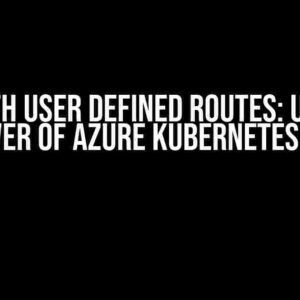In the world of secure communication, Certificate Authorities (CAs) play a vital role in verifying the authenticity of entities. However, setting up a custom CA can be a daunting task, especially when working with .NET 8 and GRPC. In this article, we’ll take you on a journey to create a custom CA without installing a root CA, unlocking the full potential of secure communication in your application.
Why Custom CA and Not Root CA?
Before we dive into the nitty-gritty, let’s understand why we might want to create a custom CA instead of using a root CA. A root CA is a trusted certificate authority that is pre-installed on most devices and browsers. While it’s convenient, it can also be a single point of failure. By creating a custom CA, you gain more control over the certificate issuance process, allowing for finer-grained control over authentication and encryption.
The Benefits of Custom CA
- Customizable certificate templates and policies
- Increased security through reduced attack surface
- Faster revocation and certificate management
- Better compatibility with specific use cases or industries
Setting Up the Environment
Before we start, ensure you have the following installed:
- .NET 8 SDK (or above)
- GRPC tools and libraries
- A code editor or IDE of your choice (e.g., Visual Studio, Visual Studio Code)
Creating a New .NET 8 Project
Create a new .NET 8 console application project using the following command:
dotnet new console -n CustomCAThis will create a new project called CustomCA. Open the project in your preferred code editor.
Generating the Certificate Authority
Now, let’s create a custom certificate authority using the OpenSSL library. Install the OpenSSL NuGet package using the following command:
dotnet add package OpenSSLNext, create a new C# class called `CertificateAuthority.cs` and add the following code:
using System;
using System.Security.Cryptography;
using System.Security.Cryptography.X509Certificates;
using OpenSSL;
public class CertificateAuthority
{
private readonly string _rootCertPath;
private readonly string _rootKeyPath;
public CertificateAuthority(string rootCertPath, string rootKeyPath)
{
_rootCertPath = rootCertPath;
_rootKeyPath = rootKeyPath;
}
public void CreateCertificateAuthority()
{
// Generate root certificate
var rootCert = CreateSelfSignedCertificate("Custom CA Root", 10);
File.WriteAllText(_rootCertPath, rootCert.ExportCertificate());
// Generate root private key
var rsa = RSA.Create();
rsa.KeySize = 2048;
var privateKey = rsa.ExportPkcs8PrivateKey();
File.WriteAllText(_rootKeyPath, privateKey);
}
private X509Certificate2 CreateSelfSignedCertificate(string subjectName, int yearsValid)
{
// Create a new certificate
var certificate = new X509Certificate2();
certificate.SubjectName = new X500DistinguishedName($"CN={subjectName}");
certificate.NotBefore = DateTime.UtcNow;
certificate.NotAfter = certificate.NotBefore.AddYears(yearsValid);
// Generate a new public-private key pair
var rsa = RSA.Create();
rsa.KeySize = 2048;
certificate.PublicKey = rsa.ExportParameters(false);
// Self-sign the certificate
certificate.SignatureAlgorithm = "SHA256WithRSA";
certificate.Signature = rsa.SignData(certificate.RawData, certificate.SignatureAlgorithm);
return certificate;
}
}This class generates a custom certificate authority with a self-signed root certificate and private key.
Configuring GRPC to Use the Custom CA
To use the custom CA with GRPC, you need to configure the GRPC server to use the custom CA certificate and key. Create a new C# class called `GrpcServer.cs` and add the following code:
using System;
using System.Security.Cryptography;
using System.Security.Cryptography.X509Certificates;
using Grpc.Core;
using Grpc.Net.Client;
public class GrpcServer
{
private readonly string _rootCertPath;
private readonly string _rootKeyPath;
public GrpcServer(string rootCertPath, string rootKeyPath)
{
_rootCertPath = rootCertPath;
_rootKeyPath = rootKeyPath;
}
public async Task StartServer()
{
// Load the custom CA certificate and key
var rootCert = new X509Certificate2(_rootCertPath);
var privateKey = File.ReadAllText(_rootKeyPath);
// Create a GRPC server with the custom CA
var server = new Server
{
Services = {Greeter.BindService(new GreeterImpl())},
Ports = { { "localhost", 5000, ServerCredentials.CreateSslServerCredentials(new[] { rootCert }, privateKey, true) } }
};
await server.StartAsync();
Console.WriteLine("GRPC server started. Press any key to stop...");
Console.ReadKey(true);
await server.ShutdownAsync();
}
}
public class GreeterImpl : Greeter.GreeterBase
{
public override async Task SayHello(SayHelloRequest request, ServerCallContext context)
{
return new SayHelloResponse { Message = "Hello, " + request.Name };
}
} This class creates a GRPC server that uses the custom CA certificate and key for secure communication.
Testing the Custom CA and GRPC Server
Now that we have our custom CA and GRPC server set up, let’s test it using a GRPC client. Create a new C# class called `GrpcClient.cs` and add the following code:
using System;
using System.Security.Cryptography;
using System.Security.Cryptography.X509Certificates;
using Grpc.Core;
using Grpc.Net.Client;
public class GrpcClient
{
public async Task CallGrpcServer()
{
// Load the custom CA certificate
var rootCert = new X509Certificate2("path/to/custom/ca/cert.pem");
// Create a GRPC channel with the custom CA
var channel = GrpcChannel.ForAddress("https://localhost:5000", new ChannelCredentials(rootCert));
// Create a GRPC client
var client = new Greeter.GreeterClient(channel);
// Call the GRPC server
var request = new SayHelloRequest { Name = "John Doe" };
var response = await client.SayHelloAsync(request);
Console.WriteLine("Response: " + response.Message);
}
}Run the GRPC server and client, and you should see the GRPC server respond with a secure “Hello, John Doe” message.
Conclusion
In this article, we’ve demonstrated how to create a custom CA with .NET 8 and GRPC without installing a root CA. By following these steps, you can gain more control over certificate issuance and revocation, while also improving the security of your application. Remember to keep your custom CA certificate and key secure, as they are the foundation of your secure communication infrastructure.
| Advantages | Disadvantages |
|---|---|
| Customizable certificate templates and policies | Increased complexity in certificate management |
| Increased security through reduced attack surface | Requires careful key management and protection |
| Faster revocation and certificate management | Limited compatibility with certain devices or browsers |
| Better compatibility with specific use cases or industries | Requires additional infrastructure and maintenance |
By understanding the benefits and trade-offs of using a custom CA, you can make an informed decision about implementing a custom CA in your .NET 8 application with GRPC.
Additional Resources
For further learning, we recommend exploring the following resources:
We hope this article has provided you with a comprehensive guide to creating a custom CA with .NET 8 and GRPC without installing a root CA. Happy coding!
Frequently Asked Questions
Get the lowdown on setting up a custom CA with .NET 8 and gRPC without installing a root CA!
What are the benefits of using a custom CA with .NET 8 and gRPC?
Using a custom CA with .NET 8 and gRPC provides more control over certificate management, improved security through reduced attack surface, and better performance due to optimized certificate chain validation. Plus, it enables you to create a more tailored and efficient certificate infrastructure that meets your specific needs!
How do I generate a custom CA certificate without installing a root CA?
You can generate a custom CA certificate using tools like OpenSSL or Certreq. For example, with OpenSSL, you can run the command `openssl req -x509 -newkey rsa:2048 -nodes -keyout ca.key -out ca.crt -days 3650 -subj “/C=US/ST.State/L.Location/O.Organization/CN=Custom CA”` to create a self-signed CA certificate. This method eliminates the need for a root CA installation!
How do I configure gRPC to use my custom CA certificate?
To configure gRPC to use your custom CA certificate, you’ll need to create a `CertificateAuthority` instance in your .NET 8 application, providing the custom CA certificate as a parameter. Then, you can use this instance to create a `ChannelCredentials` object, which can be used to create a secure gRPC channel. Easy peasy!
Can I use my custom CA certificate with multiple .NET 8 applications?
Yes, you can use your custom CA certificate with multiple .NET 8 applications! Simply share the custom CA certificate among your applications, and configure each application to use it as their trust anchor. This way, you can ensure consistency and improve manageability across your applications!
What are some best practices for managing my custom CA certificate?
Some best practices for managing your custom CA certificate include regularly rotating and revoking certificates, using secure storage and access controls, monitoring certificate usage, and implementing a robust certificate lifecycle management process. By following these best practices, you can ensure the security and integrity of your custom CA certificate!



